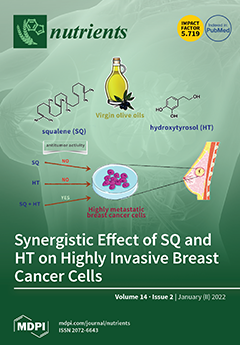The intermediate state between normal glucose tolerance and overt type 2 diabetes mellitus is associated with micro- and macrovascular diseases, requiring safe and cost-effective treatment measures interventions. A novel source of LC n-3 FAs is
Calanus finmarchicus Oil, which showed promising effects on
[...] Read more.
The intermediate state between normal glucose tolerance and overt type 2 diabetes mellitus is associated with micro- and macrovascular diseases, requiring safe and cost-effective treatment measures interventions. A novel source of LC n-3 FAs is
Calanus finmarchicus Oil, which showed promising effects on glucose homeostasis in preclinical studies due to anti-obesity effects and/or anti-inflammatory properties. In total, 43 obese patients (BMI: 31.7 ± 5.2 kg/m
2) were allocated in the following two groups: (1) Calanus oil group (2 g CO/day) and (2) placebo group (2 g paraffin oil/day). Markers of glucose metabolism, body composition and energy intake were measured at the beginning (t0), after 12 weeks (t
12) and 16 weeks (t
16). Overall, parameters reflecting abnormal glucose homeostasis and insulin resistance in the liver, including fasting insulin (−2.9 mU/L ± 4.10,
p < 0.05), HOMA-IR (−0.9 ± 1.28,
p < 0.05) and hepatic insulin resistance index (−1.06 ± 1.72 × 10
6,
p < 0.05) significantly enhanced after a 12-week CO-intervention, while no differences were observed in HbA1c, AUC
0–2h Glucose, AUC
0–2h Insulin, 2 h plasma glucose and muscle insulin sensitivity index. Our results indicate that Calanus oil causes beneficial effects on glucose metabolism and insulin resistance in obese patients, with clinical relevance to be verified in further studies. In addition, the possible active compounds and their mechanisms of action should be elucidated.
Full article






